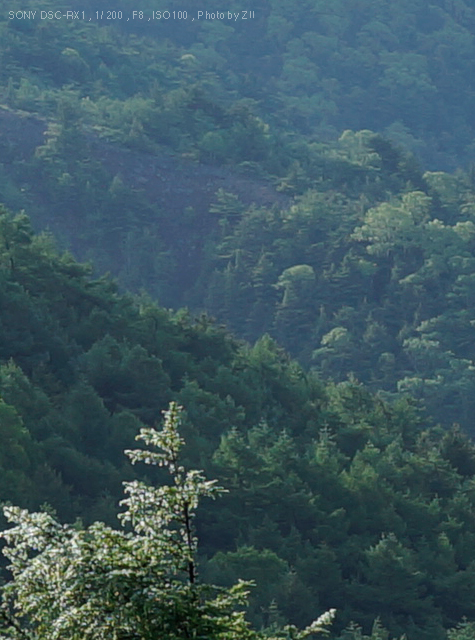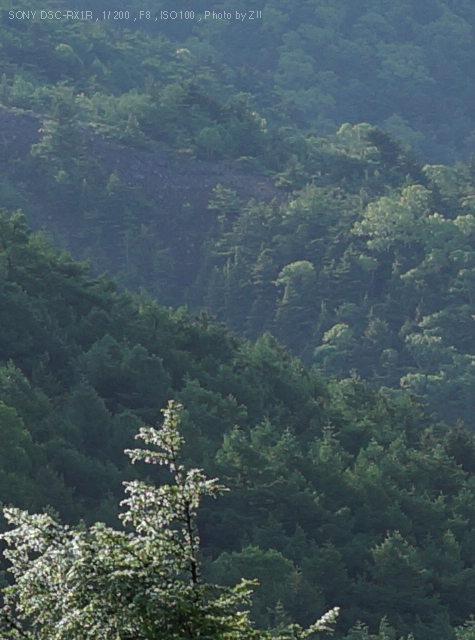PHOTO YODOBASHI
YODOBASHI CAMERA ONLINE PHOTO MAGAZINE

SONY RX1R / SHOOTING REPORT
This second report is meant to show you the performance on capturing distant subjects as promised. As mentioned in the first report, the RX1R provides even sharper images than the very sharp RX1. Everything other than the sensor is same, so I'm sure everyone is curious to know the difference the lowpass-less sensor makes. My early birding was rewarded by rich and moist forest green as you can see in the images below.
( Photography : Z Ⅱ / Text : Y.Moriki )

Powerful depiction even in the misty forest
The dew on the leaves is reflecting the branches on the sky. This is a world only become visible when you get really close to the subject. The amount of bokeh from the focus point smoothly increases to the front and the behind. Plus, the resolving power is stunning at the focus point. And, if you go back to the first image, you can find the rich white gradation. Of course, I don't expect it to capture each drop of dew, but this image is just like what I saw at the scene. This may sound odd, but I must say that it depicted "the massiveness and solidity of the air."

Another shot wide open at minimum distance. It focused on each water drop on the little leaves. And, the bokeh starting from the focus point is simply fantastic.

This one was shot at some distance. It accurately shows the layered leaves, and it minutely depicts each leaf in distance until they are melted into the highlight.
Now, this is my homework assignment. To conclude, they show the power of lowpass-less sensor. The image on the left is shot by the RX1 and the right one was shot by the RX1R. They are the jpg files generated by the cameras and 100% crops of the center area of the images. Forgive me for a little angle and lighting difference. * Actually, there was a little tonal difference, so I adjusted it to the point it doesn't influence the depiction.
If you take a look at the trees in the front, you can see the difference clearly. But, let's get more meticulous. Look at the ridgelines and edgelines of the trees in distance. You'll see there's a difference in the way the trees that you are looking at are isolated from the trees in the background. Next, look at each chunk of trees. Depending on the camera/lens performance, these distant trees can be depicted as "green surface." But, the RX1 depicts them very minutely and the RX1R surpasses it. At this distance, it's too difficult to depict each leaf, but the RX1R reproduces the unevenness in the green surface better than the RX1. The RX1 is already a powerful depicter, so we didn't expect much from the RX1R, but it's very different. However, I can also say this difference is made possible because the RX1 already has a perfect balance between the lens, the sensor, and the imaging engine.

I felt relieved to be able to submit my homework, so I came back to a human habitation. This was shot wide open from more distance than the macro shots in the second and third images. Not to mention, each leaf of grass is minutely depicted and the front and back bokeh is gentle and smooth. The bokeh in the distance doesn't get rough but rather soft and beautiful. So, you feel as if you are there. In this case, the vignetting is working nicely, don't you think?

I'm fascinated by the solid depiction of the fresh vegetable, the water surface, and the well-used wooden bucket. This is another wide open shot.

Maybe you can even imagine how you feel when you hold the containers. Maybe you can almost taste it, too. Is this also because of the lowpass-less sensor?

The depiction of the hat is wonderful. This rather intense red is perfectly reproduced without color saturation.

It even depicts this flashy bicycle maintaining tonality. Lowpass-less sensors are also good at depicting this kind of subjects.

The situation had a high contrast as you see. I was surprised at the original image file because the shadow detail remained around the ceiling even though it looked black as ink on the monitor. Also, there was some tonality in the sky behind the latticework. What a wide dynamic range it is! I felt that each pixel has more room for tonality than the RX1.

The lowpass-less sensor starts to perform its best only after the base RX1 is a thoroughbred.
To be, or not to be... I'm talking about the lowpass filter. It is used in order to reduce moiré and false colors. But, it's omitted in order to gain sharpness. Once I start thinking about this question, I get stuck in the eternal loop trying to choose one between the chicken and the egg. There's no one right answer for this question as there're good reasons of using or omitting the filter. Anyway, it's true that there're more lowpass-less cameras than before (they used to be only for professionals a couple of years ago). This is because they have been making more high-density and high-performance sensors. I may be exaggerating, but if the number of pixels is multiplied by ten to one hundred (leaving the lens performance alone this time), we may not have to worry about the moiré and false colors. So, now is the first stage of the journey to reach that level.
Dreaming aside, did you like the pictures taken by the RX1R? I'm repeating myself, but the excellent RX1 has now been upgraded further. And now, it captures the scene through the Zeiss Sonnar 2/35 more accurately. I even get lost in wild fancies: what if the Alpha-99 has this sensor? But at the same time, the depiction is realized because by using a fixed lens, there's no need to worry about the flange back distance. Oh, I'm in the loop again and I should leave the better conclusion to the third report!

